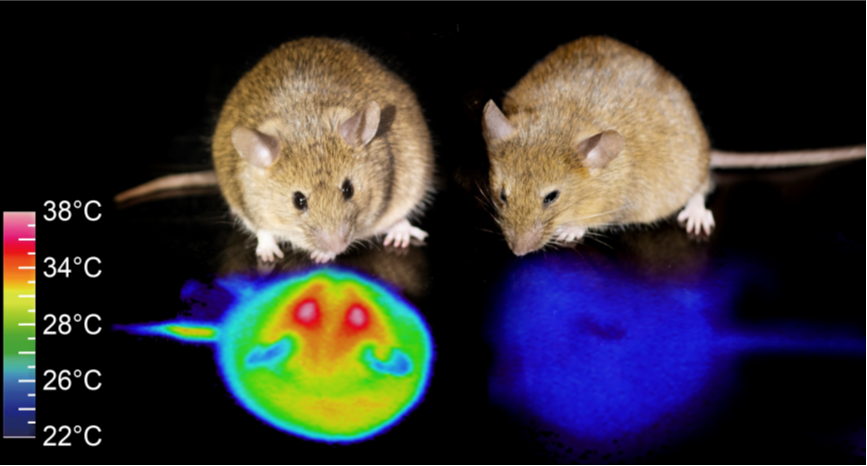 |
September 2021 Mouse of the Month |
Induction of hibernation-like state in mice
B6J.B6N-Qrfp<tm2.1(icre)Stak> (RBRC11137)
|
| Hibernation is a hypometabolic state to tolerate food scarcity in winter. Hibernating mammals actively and reversibly lower their temperature for inhibition of energy metabolism. Though it has been considered that artificial induction of hibernation in humans provides benefits to clinical application and space exploration, non-existence of useful experimental models provide barrier against hibernation-related research. Recently, Dr. Sakurai and his colleagues developed a method to induce a hibernation-like state in non-hibernating laboratory mice. They previously identified a novel hypothalamic neuropeptide QRFP (pyroglutamylated RFamide peptide) [1,2] and recently reported that activation of QRFP-positive neurons (Quiescence-inducing neurons; Q neurons) induces a hypothermic and hypometabolic state [3]. They named this hypometabolic-like state QIH (Q neuron-induced hypometabolic state). Actually, they established QIH mice by combination of Cre/loxP system (Cre driver mice for Q neuron; Qrfp-iCre mice; RBRC11137) and DREADDs (designer receptors exclusively activated by designer drugs) system (hM3Dq receptor and the agonist CNO (clozapine-N-oxide)). Behavioral and histological analysis for QIH mice showed that Q neuron activation induces a long-lasting body temperature and oxygen consumption lowers, like hibernation. Additionally, neuroscientific and genetic analysis revealed that Q neurons act on dorsomedial hypothalamus and both glutamatergic and GABAergic neurons are related with QIH induction. In the future, Further elucidation of QIH mechanism will make it possible to apply QIH. |
| Depositor | : | Takeshi Sakurai, M.D., Ph.D. University of Tsukuba |
|
| Strain name | : | B6J.B6N-Qrfp<tm2.1(icre)Stak> | |
| RBRC No. | : | RBRC11137 | |
| References | : | [1] | Takayasu S, Sakurai T, Iwasaki S, Teranishi H, Yamanaka A, Williams SC, Iguchi H, Kawasawa YI, Ikeda Y, Sakakibara I, Ohno K, Ioka RX, Murakami S, Dohmae N, Xie J, Suda T, Motoike T, Ohuchi T, Yanagisawa M, Sakai J. A neuropeptide ligand of the G protein-coupled receptor GPR103 regulates feeding, behavioral arousal, and blood pressure in mice. Proc Natl Acad Sci U S A. 2006 May 9;103(19):7438-43. |
| [2] | Okamoto K, Yamasaki M, Takao K, Soya S, Iwasaki M, Sasaki K, Magoori K, Sakakibara I, Miyakawa T, Mieda M, Watanabe M, Sakai J, Yanagisawa M, Sakurai T. QRFP-Deficient Mice Are Hypophagic, Lean, Hypoactive and Exhibit Increased Anxiety-Like Behavior. PLoS One. 2016 Nov 11;11(11):e0164716. |
||
| [3] | Takahashi TM, Sunagawa GA, Soya S, Abe M, Sakurai K, Ishikawa K, Yanagisawa M, Hama H, Hasegawa E, Miyawaki A, Sakimura K, Takahashi M, Sakurai T. A discrete neuronal circuit induces a hibernation-like state in rodents. Nature. 2020 Jul;583(7814):109-114. |
||
| September 2021 Saori Mizuno, Ph.D. Contact: Experimental Animal Division, RIKEN BioResource Research Center (animal.brc@riken.jp) All materials contained on this site may not be reproduced, distributed, displayed, published or broadcast without the prior permission of the owner of that content. |





